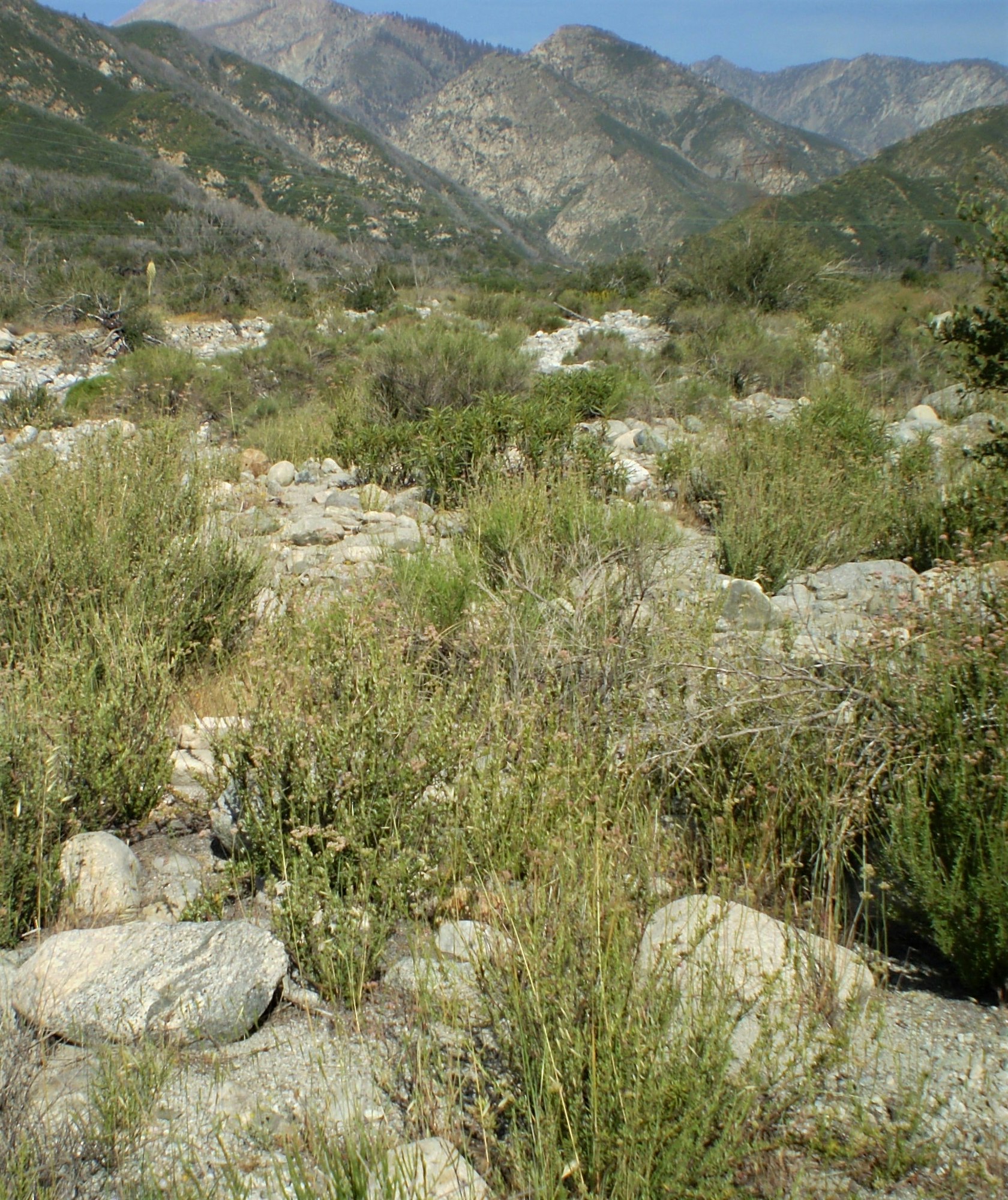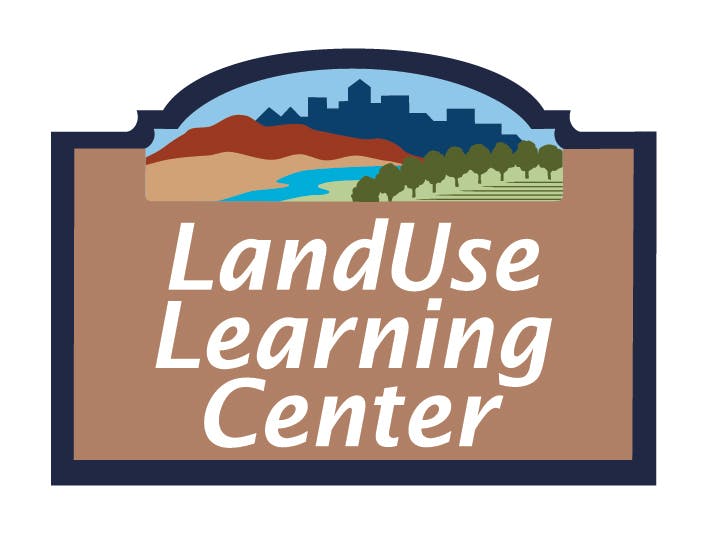Plant Communities
Throughout Southern California, and within the RCRCD district, there are diversity of native plant communities. The RCRCD works to preserve these communities through preservation, restoration and management of the lands it it holds in fee title as well as in conservation easements. Seven major types of plant communities exist within the District: riparian woodland, grassland, chaparral, coastal sage scrub, alluvial scrub, southern oak woodland and conifer forest, Since plant communities do not grow according to boundaries, there are natural transitions between these plant communities. Below are descriptions of the main plant communities found in the RCRCD district. To learn more about these habitats and to experience them in person, visit our Landuse Learning Center,
Riparian Woodland
Riparian is defined as "pertaining to the bank of a river". The riparian plant community is found along any stream, waterway, or river. Common plants include cottonwood, sycamore, willow, poison oak, and mule fat. Riparian plants are generally more water-thirsty than those of the other southern California plant communities.

Riparian habitat runs through other plant communities, as water flows from higher elevations through tributaries to the Santa Ana River. The narrow corridor of a stream is a valuable resource in our dry southern California climate. Streams that flow throughout the year are referred to as perennial and typically drain large acreages.
Perennial streams bring drinking water to wildlife and support plant growth all year long. These waterways are normally thick with vegetation providing food, homes, and movement corridors for wildlife.
Riparian woodlands are of considerable regional importance to many wildlife species as well as areas where water can be found year round. Scholars estimate that 95% of southern California's riparian habitat has been developed or degraded. Many drainage ways have been narrowed and concrete-lined or piped and filled, rendering them useless to wildlife. Riverside county is fortunate to still have many natural watercourses that provide homes, rest stops, and passageways for migrating wildlife. It is estimated that more than one third of the threatened or endangered species live solely in riparian habitats, including, the California red-legged frog, the Southwestern arroyo toad, the Southwestern pond turtle, the Least Bell's Vireo (a bird), and the Santa Ana Sucker, (a fish).
Alluvial Scrub

Alluvial Scrub plant communities play an essential role in stabilizing alluvial fans and wash habitats. The vegetation aids in the percolation of water into ground water systems and basins and in controlling erosion and flooding of downstream habitat and developments. Alluvial Scrub also serves as habitat for many rare plant and wildlife species and is considered as threatened habitat. Alluvial Scrub habitat is threatened by climate change, artificially high fire frequency, introduced species, disruption of natural erosion and deposition processes, urbanization, and other human impacts.
Alluvial scrub vegetation is variable in composition and occurs primarily on low gradient, unstable substrates of alluvial fans and along washes at the bases of inland mountain ranges and on alluvial terraces within the floodplain of the upper Santa Ana River and its tributaries.
One of the most important shrubs of Alluvial Scrub vegetation is scale broom (Lepidospartum squamatum). The species composition of Alluvial Scrub communities varies by location, depending on factors such as exposure, soil texture, time since last disturbance, water availability, elevation, frequency of fire and flooding, and the availability of intact, adjacent habitat.
Grasslands

Nearly all grasslands within the District, especially those at lower elevations are predominately introduced annual grasses. Mixed in with these are usually some native grasses and native forbs and a scattering of sub- shrubs. Upland grasslands are associated with relatively gentle topography and deeper, fine textured soils. Rare native grasslands with Purple Needlegrass (Stipa pulchra) or Foothill Needlegrass (Stipa lepida) are found on clay soils within the Santa Ana Mountains and the Gavilan Hills. The grasslands are often dominated by non-native wild oats.
There are also grasslands associated with moist, alkali-soil habitats. These sensitive grasslands are dominated by Salt Grass (Distichlis spicata). Some of the associated species include Yerba Mansa (Anemopsis californica), Alkali Heliotrope (Heliotropium curassavicum), trailing wild rye (Elymus triticoides), Alkali Heath (Frankenia salina), and Alkali Mallow (Malvella leprosa)
Chaparral

Chaparral is composed of hillside evergreen shrubs that stand from 1-15 feet tall. Chaparral communities usually develop between 1,500 and 4,000 feet in elevation where annual rainfall is 14-25 inches. Characteristic plant species include chamise, manzanita, sugarbush, scrub oak, California lilac, toyon, and sumac.
Chaparral plants have adapted to the dry, hot summers and wet, cooler winters found in southern California and are well adapted to withstand drought. Most species are active in the cooler, wetter part of the year. Many species possess leathery leaves and deep root systems that help the plants to conserve and utilize water during the hot, dry seasons. Periodic fire is also necessary for the rejuvenation of many chaparral plants. Many species sprout or produce seedlings in response to fire.
Mature stands of chaparral form dense, closed canopies. Selective clearing opens impenetrable stands of chaparral and helps prevent devastating wildfire. Pruning, grazing, and prescribed fire (controlled burns) are tools that have been used to section dense stands of chaparral. Areas of mixed chaparral (CSS interspersed with chaparral species) provide high quality habitat because they supply food and refuge to a diversity of wildlife.
Learn more about fuel reduction and fire-wise landscaping in the booklet Living on the Edge.
Coastal Sage Scrub

The coastal-sage-scrub (CSS) plant community is unique to Mediterranean climates. Commonly, CSS shrubs are part woody, aromatic, and 1-6 feet tall. Many have soft gray-green leaves and shallow root systems. Most CSS shrubs are adapted to prolonged summer-fall drought; they drop or curl their leaves and become dormant to survive dry conditions.
Characteristic plant species of CSS include California sagebrush, California buckwheat, brittle-bush, black sage, and white sage. The shrubs of Riverside area CSS (Riversidian sage-scrub) are often spaced out, providing an open canopy that allows interspersed growth of grasses, forbs, and succulents.
Nearly one hundred plant and animal species associated with CSS are classified as rare, sensitive, threatened, or endangered, including the Stephens Kangaroo Rat, the California Gnat catcher (a bird), the Cactus Wren (a bird), the Orange-throated Whiptail (a lizard), and the San Diego Horned Lizard.
Coastal-sage-scrub used to be the predominant vegetation type below 1000 foot elevation. The amount that has been lost in Riverside County is estimated to be close to 90%. Of the remaining habitat, more than half is considered degraded as a result of grazing, frequent fires, weed invasion, military activity, and off-road vehicle use.
Periodic fire is important to the regeneration of many CSS species and can help to maintain high levels of biodiversity. Fire at intervals of more than 20 years is necessary, but more frequent fire results in decreased shrub regeneration, increased invasion by non-native grasses, and a decrease in biodiversity. In addition, air pollution may contribute to the degradation of CSS by depositing abnormally high levels of nitrogen on the soil, which promotes the rapid growth of non-native grasses and other weed species.
Oak Woodland

Oak woodlands are typically found on valley floors, foothills, fault-lines, and mesas. Oak dominated landscapes have understories of grasslands or coastal-sage-scrub with forbs, leaf litter, and woody debris. Oak woodlands provide habitat for over 300 species of birds, amphibians, reptiles, and mammals.
Urban and agricultural developments have eliminated oaks from much of their former geographic ranges. Cattle grazing, introduced plant species, tree removal, increased urban runoff, and soil compaction around oak tree roots have contributed to degradation of oak-woodland systems.
Two phases of the southern oak woodland exist within the District. The phases are known as the Englemann Oak phase and the Coast Live Oak phase. Isolated trees, prominently of Englemann Oak, and drier soils characterize the Englemann Oak phase. Coast Live Oak and California Walnut dominate the denser (over 30% cover), widespread woodland of the Coast Live Oak phase. Generally, this phase is found on the moister slopes, along fault lines, and by riparian areas within the District. This community can be found at elevations up to 5,000 feet. Precipitation ranges from 15-25 inches per year with a considerable amount of runoff if slopes are steep.
Conifer Woodland

The conifer woodland community is of two major types within our District, the Coulter Pine (Pinus coulteri) Woodland alliance and the Bigcone Douglas-Fir (Pseudotsuga macrocarpa) Woodland alliance, found at elevations between 4,000 and 5,500 feet in the Santa Ana Mountains. Precipitation, sometimes in the form of snow, can range between 25-45 inches per year. The soils are mostly residual upland soils and are moderately to strongly acidic. Other plants within these communities can include: Canyon Live Oak, Coast Live


